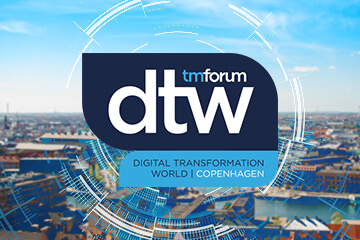DTW 2022: plenty of answers, and still plenty of questions

Our return to Digital Transformation World, this time in Copenhagen, was our second big event of the year, after the not quite full MWC back in February. In contrast to that behemoth of an event, while this is a much smaller affair, it’s still a good size and it felt as well attended as planned.
The other core difference is in the companies presenting there, and in the focus of the event – or lack thereof in Barcelona. At times, it’s hard to know what kind of show MWC is – between the gadgets, cars, and bits of network equipment, with no clear purpose, the important subjects like billing can get lost in the noise. At DTW, almost everyone and everything was relevant to BSS/OSS, there was still an F1 car there though, so don’t worry, it wasn’t completely without the gadgets!
The exhibition centre was laid out in three main zones: the entrance area was a large hall for relaxing and keeping up with the conference on the big screen; the main area, where all the exhibitors were, along with the catalyst projects; and finally, the seminar rooms containing the various conference streams, broadly categorised this year as Growth, Tech, and Data & AIOps.
On our stand, the show felt very positive. It’s still early in the “post”-Covid world for face-to-face events and meetings to feel fresh, but it was more than that. Of course, one of the highlights of the conference was our very own Richard Doughty, on a panel discussion about migration strategies. Some might think it not the most exciting subject in the world, but for transformation projects, it’s a vital component, and one we’ve got plenty of experience in. A packed out seminar room left us standing at the back – a sign that many of the delegates recognise the importance too.
I was excited to sit in on a couple of sessions covering enterprise 5G and network slicing. Surely at these, I thought to myself, I’d hear all about the use cases that enterprises and telcos had been coming up with to match the industry hype.
Unfortunately, in both sessions, there was a distinct lack of anyone asking for these; it was all a bunch of people trying to sell technology to them. Network slicing in particular seems to be a solution looking for a problem, and across the board, the general message was that 5G is a disappointment, the monetisation was the same as for 4G.
The final session was a popular one on the metaverse. Though I’m still sceptical, I did hear one thing that answered one of my key questions around interoperability. It’s all very well and good being able to buy a thing – whether it’s a character, building, handbag or whatever – in a virtual world, probably as an NFT on a blockchain, but what use is that if you can only use it in a certain game/metaverse?
The Metaverse Standards Forum is aiming to solve the many questions as to how this will all work, but if they get that right, it will go a long way to making virtual goods actually worthwhile. It was interesting to hear how Accenture now onboards all its new joiners via its own internal VR application, with positive feedback from people going through the project. SK Telecoms, usually at the forefront of new tech ideas has strong engagement in its metaverse with 2 million active users, but to me, the key will be about being able to keep people coming back.
However, I’m yet to see anything in a metaverse that is easier to use than an existing technology, and it seems that even the people at Meta, who are building the flagbearer metaverse, agree, with a plan to make managers accountable for their staff logging in at least once a week. Nothing gives you a sense of the value as much as having to force people to use it!
A general trend in a lot of discussions was the move to a pure product, pre-integrated, end-to-end suite being a good thing; whether it was the Nuuday CEO keynote talking about how that is what they chose, and how any customisations must be signed off by him personally, or vendors talking about their latest releases, this is obviously good news for companies like us who have been banging this drum for years, and until recently, against the prevailing wind.
Where I found this interesting however, especially at a TM Forum event, was the disconnect between this and the push for individual interchangeable modules, with the aim under the ODA program for those modules to get smaller and smaller. Will we ever get to the point as an industry that doing so can be so painless it will be worth looking at best-of-breed again? It’ll be interesting to see how that plays out over the next few years.
Overall, it was a great show, and we’ll most definitely be back next year, so I look forward to seeing you there!

